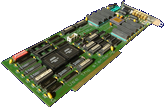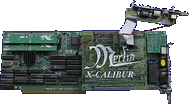Manufacturer “X-Pert Computer Services”
4 expansions in database
Manufacturer X-Pert Computer Services / Village Tronic, Germany | Date 1992 | Amiga A2000, A3000, A4000 | Interface Zorro II | Autoconfig ID 2162 / 1,22167 / 1,2 |
- RTG graphics card
- the card has a standard ISA connector with a PC display card plugged into it
- Tseng Labs ET4000
- 1 MB RAM
- six predefined screen modes
- 1280×1024 87 Hz interlaced, up to 16 colours from a 18 bit (262144) palette
- 1152×900 60 Hz, up to 256 colours from 18 bit
- 1120×832 65 Hz, up to 256 colours from 18 bit
- 1024×768 70 Hz, up to 256 colours from 18 bit
- 800×600 72 Hz, up to 32768 colours from a 15 bit (32768) palette
- 640×480 81 Hz, up to 32768 colours from 15 bit
- notes
- socket for monitor switcher
- video passthrough connector
- HD15 VGA connector
- CyberGraphX 2, Picasso96, EGS and custom drivers
- supported by NetBSD and OpenBSD
- Domino-ADPro.dms
ADPro tool disk
10 kB - Domino-System-24.dms
system disk (village.library v2.4)
39 kB - Domino-System-25.dms
system disk (village.library v2.5)
195 kB
Manufacturer X-Pert Computer Services / Prodev, Germany | Date 1993 | Amiga A2000A3000, A4000 | - - | Interface Zorro IIZorro III | Autoconfig ID 2117 / 3,4,201 |
- RTG graphics card
- Tseng Labs ET4000W32
- 85 MHz dot clock in 8 bit modes
- Brooktree Bt482 RAMDAC with hardware cursor
- 2 or 4 MB DRAM
- although the Merlin was advertised to support 8 or 16 MB, that would be possible with ET4000W32i or ET4000W32p chips only
- only 2 MB is possible in Zorro II mode
- two SIMM sockets for custom made SIMMs
- 1× 2 MB, 32 bit (labeled as "2 MB 32 Bit")
- 2× 2 MB, 16 bit (labeled as "2 MB")
- 1× 4 MB, 32 bit, 60 ns
- the clock speed of the blitter and memory can be selected with jumpers between 50-65 MHz (55 MHz is the default setting)
- optional video module, X-Calibur (
- activates the S-VHS and Composite output connectors
- provides RGB, S-VHS and Composite inputs on a separate slot cover
- the RGB input is fake - the signal is converted to NTSC Y/C and then digitized
- the ProDev digitizing software supports the Composite input only
- provides up to 800×600 @ 16 bit
- works only in Zorro II mode because the ET4000W32 does not support digitizing in its 32 bit mode
- a switch is provided for easy switching between Z2 and Z3 modes (connects to the Z2/Z3 jumper)
- notes
- a genlock module was developed but never sold
- the design of Merlin was not finished when the card went into production, leading to many problems
- compatibility problems with other Zorro cards
- incompatibility with 060 processors
- incompatibility with all GVP processor cards
- reset problems
- the small registers of the ET4000 chip led to problems with 24 bit screens larger than 680×576 (8 and bit screens have no problems)
- X-Pert and ProDev both offered fixes but only ProDev's methods could cure all problems
- Ingenieurbüro Riedel still offers fixing of problematic Merlin cards
- HD15 VGA connector
- S-VHS, RGB, F-BAS output connectors
- automatic monitor switch and video pass through
- every Amiga graphics function is supported except the Copper
- if more than one screen is opened the next one can be seen through a window on the foremost screen
- Picasso96, EGS and ProBench drivers
- supported by NetBSD and OpenBSD
- merlin-e.pdf
Ingenieurbüro Riedel
merlin hardware fix (incl. 060 fix)
26 kB - merlin.pdf
Ingenieurbüro Riedel
Merlin Umbauanleitung (incl. 060-Fix)
20 kB - Merlin.pdf
Anleitung / User manual (german)
9.8 MB
- Merlin_ADPro-11.dms
HRG-ADPro driver v1.1
109 kB - Merlin_Install-136.dms
install disk v1.36
657 kB - Merlin_Install-144.dms
install disk v1.44
663 kB - Merlin_ProBench-110.dms
ProBench upgrade v1.10
557 kB - Merlin_ProBench-21-1.dms
ProBench upgrade v2.1, disk 1
366 kB - Merlin_ProBench-21-2.dms
ProBench upgrade v2.1, disk 2
580 kB - Merlin_ProBench-22-1.dms
ProBench upgrade v2.2, disk 1
366 kB - Merlin_ProBench-22-2.dms
ProBench upgrade v2.2, disk 2
582 kB - ProBench3-10up.lha
Aminet
ProBench 3.1 update 10
86 kB - ProBench3-9.lha
Aminet
ProBench 3.1 update 9
280 kB
Manufacturer X-Pert Computer Services / Viona Development, USA | Date 1990 | Amiga A2000, A3000, A4000 | Interface Zorro II | Autoconfig ID 2117 / 1,2 |
- RTG graphics card
- Inmos IMS G300C (85, 110 or 135 MHz) programmable RAMDAC and sync generator
- no blitter, line drawing engine, or other general purpose graphics processing capability
- Visiona Paint: 2 MB 20 ns VRAM in 16 ZIP sockets
- Visiona Paint+: 4 MB 20 ns VRAM in 32 ZIP sockets
- screen modes
- maximum resolution is only limited by the amount of VRAM installed
- 24/32 bit: up to 1024×1024
- 8 bit: up to 2048×2048
- 2 bit: up to 4096×4096
- 1 bit: up to 8192×4096
- the resolutions above need 4 MB VRAM - with 2 MB VRAM, the maximum resolution is limited
- maximum horizontal frequency: 80 kHz
- resolutions above 1600×1280 flicker badly
- notes
- Visiona Paint can be converted to a Visiona Paint+ by adding 16 RAM chips and a new control PAL
- the VRAM uses 2 resp. 4 MB in the Zorro II address space:
- limits Zorro II RAM expansions to 6 resp. 4 MB
- the VRAM can be used by the Amiga as memory expansion using Addmem program (Visiona library must not be activated)
- content of the Video RAM can be changed by the CPU and the Video Controller (which accesses the Video RAM with a DMA controller)
- two separate oscillators for PAL and NTSC signals - two additional sockets for eg. SECAM
- 15 pin VGA connector
- five HF-PCB connectors
- supports several Sync options:
- output: separate H-Sync/V-Sync, Composite Sync on H-Sync, Sync-on-Green
- input: external synchronization (on H-Sync) with a TBC possible (needs small hardware expansion)
- EGS driver
- the Visiona, the GVP EGS-110/24 and EGS-28/24 Spectrum were all designed by Hendrik Horak
- DIP switch settings
| Jumper | Description | ON | OFF |
| 1 | Amount of Video RAM | 4 MB | 2 MB |
| 2 | ROM selection | selected | deselected |
| 3 - 6 | reserved | - | - |
| 7 | Video Standard | NTSC | PAL |
| 8 | Interlace setting | Interlace on | Interlace off |
| 9 | not used | - | - |
- Visiona.pdf
Bedienungsanleitung / german user manual
1350 kB
- Visiona_Demos-1.dms
Demos Disk 1
471 kB - Visiona_Demos-2.dms
Demos Disk 2
411 kB - Visiona_Demos-3.dms
Demos Disk 3
589 kB - Visiona_Demos-4.dms
Demos Disk 4
682 kB - Visiona_Demos-5.dms
Demos Disk 5
778 kB - Visiona_Imagemaster.dms
ImageMaster Disk
22 kB - Visiona_Libs.dms
Libs Disk
126 kB - Visiona_System-10.dms
System Disk v1.0
311 kB - Visiona_System-134.dms
System Disk v1.34
310 kB - Visiona_TV-Paint_Demo-18.dms
TV-Paint Demo v1.8
220 kB - Visiona_Tools-13.dms
Tools Disk v1.3
317 kB - Visiona_Tools-134.dms
Tools Disk v1.34
300 kB
Manufacturer X-Pert Computer Services / Prodev, Germany | Date 1993 | Amiga A2000, A3000, A4000 | Interface special (see text), |
- X-Calibur is the optional video module of Merlin
- activates Merlin's S-VHS and Composite output connectors
- provides S-VHS and Composite inputs
- it runs only in Z2 mode of Merlin, due to limitations of the ET4000W32
- a switch is provided for easily switching Merlin between Z2 and Z3
- Merlin_X-Calibur.pdf
Flyer (german)
932 kB
 Amiga Hardware Database
Amiga Hardware Database


























